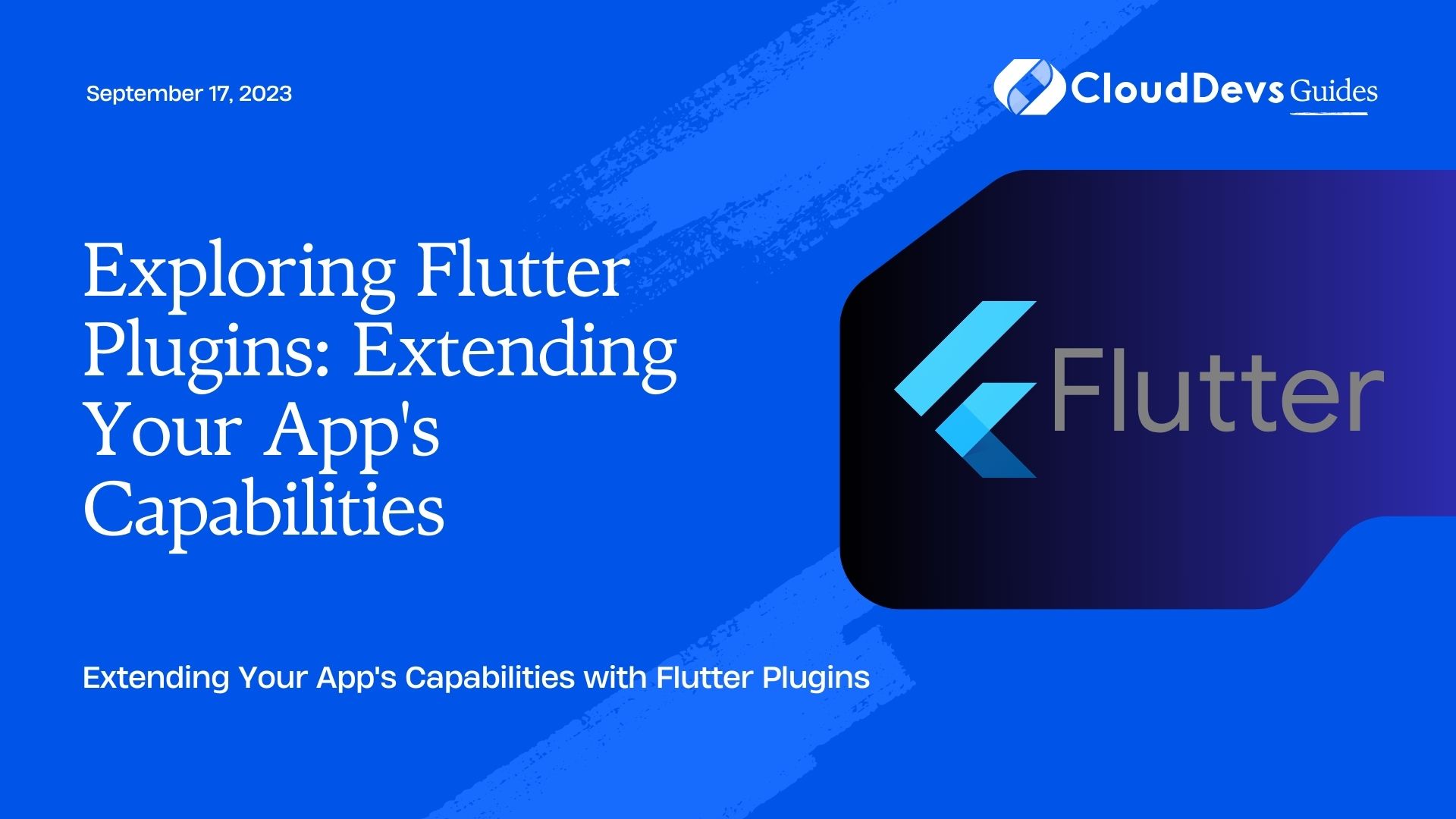Exploring Flutter Plugins: Extending Your App’s Capabilities
In today’s competitive app development landscape, creating an app that stands out requires more than just a great user interface and smooth navigation. Users now expect apps to offer a wide range of functionalities that can address their diverse needs. This is where Flutter plugins come into play, enabling developers to seamlessly integrate external capabilities into their apps. In this blog post, we will dive deep into the realm of Flutter plugins, understand their significance, explore different types of plugins, and learn how to integrate them into your Flutter app.
1. Understanding Flutter Plugins
At its core, Flutter is an open-source UI software development toolkit that allows developers to create natively compiled applications for mobile, web, and desktop from a single codebase. Flutter’s widgets offer a consistent and customizable user interface, but what if you need to integrate features beyond the built-in components? This is where Flutter plugins enter the picture.
1.1 What Are Flutter Plugins?
Flutter plugins are packages of code that provide access to device functionalities, APIs, and native code libraries. They bridge the gap between Flutter’s framework and platform-specific code, allowing developers to access a wide range of device features without leaving the Flutter environment. Whether you need to work with device sensors, access platform-specific APIs, or even integrate third-party services, there’s likely a Flutter plugin available to help you achieve your goal.
1.2 Benefits of Using Flutter Plugins
Using Flutter plugins offers several key advantages that contribute to the efficiency and effectiveness of app development:
1. Reusability
Flutter plugins encapsulate platform-specific code, making it reusable across different projects. Once you’ve created or found a plugin that suits your needs, you can easily integrate it into multiple apps without rewriting the same functionality each time.
2. Time Savings
Developers can save significant development time by leveraging pre-built plugins. Instead of spending hours or days implementing complex features from scratch, you can quickly integrate plugins that have already been developed, tested, and optimized.
3. Access to Native Features
Flutter plugins provide a bridge to native device features that might not be accessible through Flutter’s core framework. This includes functionalities like accessing device sensors, utilizing the camera, working with geolocation, and more.
4. Seamless Integration
Thanks to Flutter’s hot reload feature, integrating plugins is a smooth process. You can quickly see the changes and test the plugin’s functionality in real-time, which aids in the development and debugging process.
5. Community-Driven Development
The Flutter community actively develops and maintains a vast collection of plugins. This means you have access to a wide range of plugins created by experts in various domains, ensuring the plugins are up-to-date and well-maintained.
2. Exploring Different Types of Flutter Plugins
Flutter plugins cover a broad spectrum of functionalities, catering to a wide variety of app development needs. Let’s explore some popular types of plugins:
2.1. Device Functionality Plugins
These plugins grant access to device-specific features such as the camera, accelerometer, gyroscope, and more. For instance, the camera plugin allows you to seamlessly integrate camera functionalities into your app, opening up possibilities for building barcode scanners, photo editors, and augmented reality experiences.
dart import 'package:camera/camera.dart'; // Get the list of available cameras List<CameraDescription> cameras = await availableCameras(); // Create a CameraController CameraController controller = CameraController(cameras[0], ResolutionPreset.high); // Initialize the camera await controller.initialize(); // Display the camera preview CameraPreview(controller);
2.2. Firebase Plugins
Firebase plugins provide integration with Google’s Firebase platform, offering functionalities like authentication, real-time databases, cloud messaging, and more. The firebase_auth plugin, for example, lets you easily implement user authentication and authorization in your app.
dart import 'package:firebase_auth/firebase_auth.dart'; // Create an instance of FirebaseAuth FirebaseAuth auth = FirebaseAuth.instance; // Sign in with email and password UserCredential result = await auth.signInWithEmailAndPassword( email: "user@example.com", password: "password123", ); // Get the user's ID String userId = result.user.uid;
2.3. Networking Plugins
Networking plugins facilitate communication between your app and external APIs, enabling tasks such as making HTTP requests, fetching data, and sending data. The http plugin simplifies the process of making GET and POST requests.
dart
import 'package:http/http.dart' as http;
// Make a GET request
var response = await http.get(Uri.parse('https://api.example.com/data'));
// Parse the response JSON
var data = json.decode(response.body);
2.4. UI Enhancement Plugins
UI enhancement plugins offer custom widgets, UI components, and design elements that can seamlessly integrate into your app’s existing UI. The flutter_svg plugin allows you to render SVG images within your Flutter app.
dart
import 'package:flutter_svg/flutter_svg.dart';
// Display an SVG image
SvgPicture.asset('assets/image.svg');
3. Integrating Flutter Plugins into Your App
Now that we’ve explored the benefits and types of Flutter plugins, let’s dive into the process of integrating them into your app:
3.1. Adding Dependencies
To use a Flutter plugin in your app, you need to add its dependency to your app’s pubspec.yaml file. For instance, to use the camera plugin, add the following line:
yaml dependencies: camera: ^0.10.0
After adding the dependency, run flutter pub get to fetch and install the plugin.
3.2. Importing and Using Plugins
Import the plugin in your Dart code and follow the plugin’s documentation to initialize and use its functionalities. For example, using the camera plugin:
dart import 'package:camera/camera.dart'; List<CameraDescription> cameras = await availableCameras(); CameraController controller = CameraController(cameras[0], ResolutionPreset.high); await controller.initialize(); CameraPreview(controller);
3.3. Testing and Debugging
Flutter’s hot reload feature enables you to quickly iterate and test your plugin integration. Make changes to your code, save, and observe the changes immediately without restarting the app.
3.4. Handling Permissions
Some plugins require permissions to access certain device features. Ensure that you request the necessary permissions in your app and handle permission-related scenarios gracefully.
Conclusion
Flutter plugins are a powerful tool for extending your app’s capabilities by integrating device features, external services, and UI enhancements seamlessly. With the vast array of available plugins and the community’s continuous contribution, you can save time, improve functionality, and offer a richer user experience. As you explore the world of Flutter plugins, you’ll find that your app’s potential is virtually limitless. So, take the plunge, explore various plugins, and elevate your Flutter app to new heights of functionality and innovation. Happy coding!
In this blog post, we’ve delved into the world of Flutter plugins, understanding their significance, benefits, types, and the process of integration. With Flutter’s plugin ecosystem continually evolving, the potential to extend your app’s capabilities is boundless. So go ahead, enhance your app with plugins, and provide your users with an even more delightful and feature-rich experience.
Table of Contents









